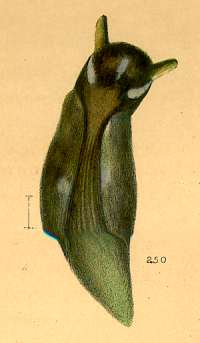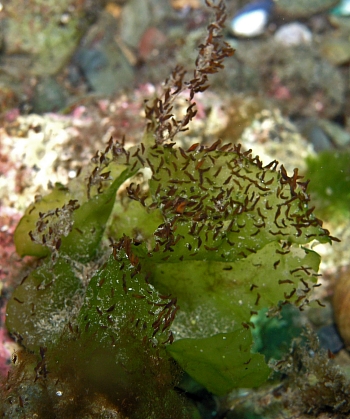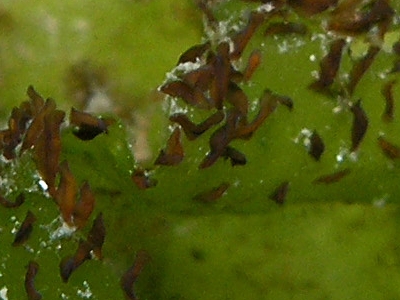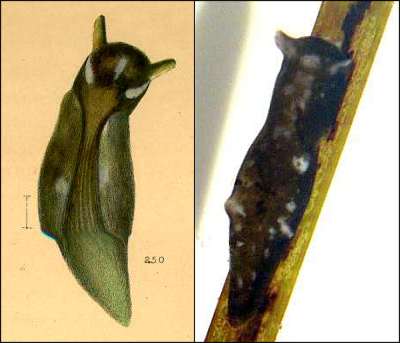
Elysia catulus
(Gould, 1870)
Order: SACOGLOSSA
Superfamily: ELYSIOIDEA
Family: Elysiidae
DISTRIBUTION
Atlantic coast of Nth America from Nova Scotia to South Carolina.
PHOTO
Placobranchus catulus -from a drawing by Toppan of an East Boston specimen. Gould, 1870: PLATE XVII. Fig. 249.
Small elysiid reaching approximately 6mm in length. The body is heavily pigmented with black but the greenish tinge of the body contents can be seen on close examination. Whitish marks form a regular pattern: There is an elongate one on the head between the rhinophores, and similar ones on each side of the head running across the eyes. There are up to three white patches at the edge of the parapodia, one at the front, one midway down, and sometimes a third at the back, where the parapodia runs into the posterior tip of the foot. This species feeds on the sea grass Zostera and its name catulus [little cat] is a reference to its likeness to a small cat.
As is discussed elswhere on the Forum, Elysia serca is most probably the same species
References:
• • Bleakney, J.S., 1996 Sea Slugs of Atlantic Canada and the Gulf of Maine. Nimbus Publishing & Nova Scotia Museum, Halifax, Nova Scotia.
• Gould, A.A. (1870). Report on the Invertebrata of Massachesetts. Wright and Potter: Boston. 524pp.
Rudman, W.B., 2004 (March 11) Elysia catulus (Gould, 1870). [In] Sea Slug Forum. Australian Museum, Sydney. Available from http://www.seaslugforum.net/find/elyscatu
Related messages
Elysia serca in Newfoundland?
April 1, 2008
From: Ryan Murphy

Hi Bill,
I've frequently noticed pieces of Ulva covered with uniform shapes like this one here.
I decided to take a quick picture to see what they were. The shape of the head and body reminded me a lot of the Elysia chlorotica I was working with in New Brunswick. I see that Newfoundland is way beyond the range of E. serca, and even past the range of E. catulus (if they are indeed separate species). Are there other candidates I'm not thinking of?
Locality: Tapper's Cove, approx. 15 m, Newfoundland, Canada, Atlantic Ocean, Torbay, 20 October 2007, gravel bottom. Length: approx. 5 mm. Photographer: Ryan Murphy.
Thanks,
Ryan
rmmrphy@mta.ca
Murphy, R.M.J., 2008 (Apr 1) Elysia serca in Newfoundland?. [Message in] Sea Slug Forum. Australian Museum, Sydney. Available from http://www.seaslugforum.net/find/20996
Dear Ryan,
It is a bit hard to make out much detail in your photo, but if you are familiar with the shape of Elysia chlorotica then I guess we are not looking at a flatworm infestation. Elysia catulus is the most likely identification, and just because it has not been reported north of Nova Scotia certainly does not rule out the likelihood of it being found in Newfoundland.
As far as I can find, E. catulus has only been reported to feed on the sea-grass Zostera, which makes it almost unique amongst the sacoglossans. As is discussed elsewhere on the Forum, E. serca is an extremely similar species from further south on the west Atlantic coast and is probably the same species. Interestingly it is reported to feed on a variety of sea-grasses and also Ulva, which your animals are also apparently feeding on. It would be interesting to know if this snimal also occurs on Zostera in Newfoundland. Perhaps it changes food seasonally?
Best wishes,
Bill Rudman
Gould's Placobranchus catulus
March 12, 2004
From: Bill Rudman

While preparing Marina's messages [12391, #12392] I tried, without success, to find a good illustration or photo of Elysia catulus to compare with E. serca.
I have included here a copy of the painting in Gould's description of E. catulus alongside on of Marina Pod specimens for E. serca from the Bahamas. The whitish markings on E. catulus seem to be identical to the markings on some of Marina's animals even though the background colour is very variable. Other authors have suggested that there is more melanin in northern populations of 'E. catulus' but some of Marina's animals show plenty of melanin in the Bahamas. I would strongly agree with Kathe Jensen's suggestion that E. serca and E. catulus are the same species.
PHOTO: Left: Placobranchus catulus 'East Boston specimen'. Gould, 1870. Pl. 17, fig. 249. Right: Great Exuma, Bahamas, Western Atlantic. Depth: 1m. Length: 4mm. February 03, 2004. Photo: Marina Poddubetskaia
• Gould, A.A. (1870). Report on the Invertebrata of Massachesetts. Wright and Potter: Boston. 524pp. Pl. 17, fig. 249.
• Marcus, Ev. (1972) Notes on some opisthobranch gastropods from the Chesapeake Bay. Chesapeake Science, 13(4): 300-317.
